Climate change and food security of India: adaptation strategies for the irrigation sector
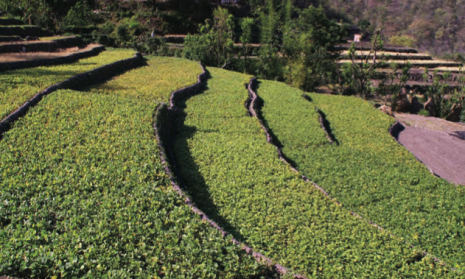
Summary
Creation of a large irrigation potential has been the cornerstone of India’s agricultural growth and past food security.
It is estimated that the irrigation sector in the country will be affected considerably by climate change due to a projected increase in absolute rainfall, intensity of precipitation, glacial-melt and flood, as well as drought events.
These changes are projected to modify the supply of both surface and groundwater in each region. Climate change is likely to increase the demand for groundwater to manage increasing intermittent periods of limited water availability.
Simulation studies on Indian river basins have shown that the availability of water in some parts of the country may decrease while there may be an enhanced intensity of floods in other parts of the country.
Several adaptation strategies are available for the irrigation sector. These include increasing the availability of usable water by conserving water resources, increasing the recharge and use of industrial and sewage wastewater.
Other options are improving the efficiencies for water use, management of groundwater, water transfers between basins, trans-boundary cooperation and the increased use of modern tools in water resource management, such as remote sensing and GIS, and real time weather forecasts.
It is concluded that demand management options will have a higher adaptation payoff than supply options.
Key words: Climate change, irrigation, adaptation, India
Introduction
The contribution of agriculture and its allied sectors to the Gross Domestic Product of India has decreased to 14.5% in 2010-11, compared with 43% in the 1970s.
However, it still plays a critical role in food production, employment and livelihood security for 58% of people.
After a period of stagnation between 1995 and 2005, agricultural production is now increasing; in 2011- 12, food grain production was close to 250 M tons.
It is estimated that the requirement for food grains will increase at a higher rate than the rising population and income (1). Hence the pace of food production must be accelerated.
Climate change is projected to cause significant adverse impacts on the agriculture of tropical regions such India (2, 3).
Combined with increased competition for land, water and labour from non-agricultural sectors, climate change and an associated increase in climatic variability will result in considerable seasonal/annual fluctuations in food production.
All agricultural commodities, even today, are sensitive to climatic variability, such as droughts, floods, tropical cyclones, heavy precipitation events, hot extremes, and heat waves. All these are known to negatively impact agricultural production and farmers’ livelihoods.
There will be an overall reduction in the quantity of available water in the future.
This paper explores the potential impact of climate change on Indian agriculture from the perspective of water management and irrigation need within a diversifying and expanding economy.
Climate change in India
Several studies have shown a warming trend in air temperature during the last few decades. An analysis (4) for the period 1901-2009 showed an increase of mean annual temperature of 0.56°C per 100 years.
It also indicated that there was a much higher increase in the post-monsoon and winter season’s temperature (0.7°C to 0.77 °C/100 years) as compared to the monsoon (0.33 °C/100 years) and pre-monsoon season (0.64 °C/100 years).
Annual rainfall over India does not show any clear trend of change; however, the winter season rainfall shows a decreasing trend, and the post- monsoon season shows an increasing trend.
The frequency of extreme rainfall also increased over the Indian monsoon region during the southwest monsoon (4). This is accompanied by a decreasing trend in smaller rainfall events.
The IPCC has projected that the increase in global mean annual surface air temperature by the end of this century is likely to be in the range of 1.8 to 4.0°C (5). For South Asia, the projections are rises of 0.5 to 1.2°C in mean annual temperature by 2020, 0.88 to 3.16°C by 2050 and 1.56 to 5.44°C by the end of the century, depending on future development including rise in population.
Overall, the temperature increases are likely to be much higher in the rabi (winter) season than in the kharif (monsoon) season.
It is also likely that hot extremes, and heavy precipitation events will become more frequent. Most climate models project an increase in the absolute amount of precipitation in future in all months except in the period between December-February, when it is likely to decrease.
The increase may, however, be accompanied by heavier precipitation events and fewer rainy days leading to increased frequency of floods and droughts in the region.
Impact of climate change on agriculture
Several studies have shown that unless we adapt there is a probability of a 10-40% loss in crop production in India by the end of the century owing to global warming, despite the beneficial aspects of increased atmospheric CO2 (2, 3).
There is some evidence that changing climate has already impacted rice and apple yields (2, 3). Projections indicate the possibility of a loss of 4-5 million ton of wheat for each 1oC temperature rise throughout the growing period (2).
Recent simulation analyses have indicated that rainfed maize, sorghum and rice yields are likely to be adversely affected by the increase in temperature, although increased rainfall and change in management practices can partly offset those losses (6, 7, 8). In general, most of these studies assume no new technology development, and no, or limited, adaptation by all stakeholders.
The projected increase in drought and flood events could result in greater instability in food production and threaten the livelihoods of farmers.
This is well-illustrated by the fact that in the recent drought of 2002, 15 Mha of the rainy-season crop area and more than 10% of production was lost.
Similar losses were noticed in the 2009 drought. Increased production variability could perhaps be the most significant effect of climate change on Indian agriculture and food security. The nutritional quality of cereals and pulses may be moderately affected by the increase in temperatures which, in turn, will have consequences for nutritional security.
Small changes in temperature and humidity can affect the virulence of different pests and diseases, so that pest and disease interactions are also likely to change significantly with climate change.
This will affect distribution and potential crop losses. Changes in rainfall, temperature and wind-speed pattern may also influence the migratory behaviour of locusts and other insects.
Climate change and water resources
Of the total precipitation of around 4000 km3 in the country, the availability from surface water and replenishable groundwater is estimated at 1869 km3.
Owing to variations of topography, and an uneven distribution of rain over space and time, only about 1123 km3, including 690 km3 from surface water, and 433 km3 from groundwater resources can be put to beneficial use (9).
India has twenty river basins, as shown in Figure 1. The 12 major basins have a total catchment area of 2.53 Mkm2.
The largest is the Ganga- Brahamputra-Meghna system, which has an area of about 1.1 Mkm2 (more than 43% of the total catchment area of all the major rivers in the country). The other major basins with catchment areas of more than 0.1 Mkm2 are those of the Indus, Mahanadi, Godavari and Krishna. There are a further 46 medium river basins with catchment areas of between 2000 and 20 000 km2, totalling about 0.25 Mkm2.
Creation of a large irrigation potential has been the cornerstone of India’s agricultural growth and past food security. This will be affected considerably by climate change, as well as by future changes in the effectiveness of irrigation methods (10).
Climate change scenarios impact on the hydrological cycle, which, in turn, is likely to result in (i) greater rainfall intensity; (ii) decrease in the number of rainy days; (iii) overall increase in precipitation; (iv) an initial increase in glacial melt and runoff, followed by a decrease; (v) increase in runoff and reduced ground water recharge and (vi) an increase in flood as well as drought events.
These changes will affect the supply of water from inflow from rivers, reservoirs, tanks, ponds and total replenishable groundwater resource.
The predicted increase in precipitation variability, which implies longer drought periods, would lead to an increase in irrigation requirements, even if total precipitation during the growing season remains the same.
Overall, therefore, irrigation demands could become even greater if rain-fed areas are not able to meet projected food needs. The IPCC (11), has projected a significant increase in runoff in many parts of the world, including India.
As the increase will be largely in the wet season the extra water will not be available in the dry season, unless water storage infrastructure is increased greatly. The extra water in the wet season, on the other hand, may increase the frequency and duration of floods.
It has been observed by remote sensing that several monsoon influenced glaciers are retreating (12). The increased melting and recession of glaciers associated with climate change could further alter the run-off (13).
Any increase in glacier melt in the Himalayas is likely to affect the availability of irrigation water, especially in the Indo-Gangeticplain. This will, in turn, have consequences on food production and food security.
Groundwater is crucial, even where crops are irrigated, to ensure stress-free periods in crop growth. Climate change is thus likely to increase the demand for groundwater to facilitate irrigation management.
Lower groundwater tables and the resulting increase in the energy required to pump water will make irrigation more expensive. Peak irrigation demands are also predicted to rise owing to a predicted increase in periods of severe heat stress.
This will increase competition between agriculture and all water consumers, including urban industry.
A detailed simulation study on the impact of climate change on water resources in the Indian river systems (14) concluded that in future, the availability of water in some parts of the country may decrease while there may be enhanced intensity of floods in other areas.
The basins of the rivers Mahi (Gujarat), Pennar (Tamil Nadu), Sabarmati, Luni and Tapi will also face water shortage conditions (15). The basins of the Cauvery, Narmada and Krishna will experience seasonal or regular water-stressed conditions. The Godavari and Mahanadi rivers will not have water shortages but are predicted to face flooding.
Adaptation strategies in the agriculture sector
In view of the projected adverse effects of climate change on food production, we need to analyze the options that could improve India’s ability to adapt.
There is considerable traditional wisdom in the region that is valuable for adapting to climatic risks. Sharing such experiences accumulated over centuries could be useful at the household, community and national level.
The region has adapted to previous climatic stresses by resorting to mixed cropping, changing varieties and planting times, by diversifying sources of income for farmers, and maintaining buffer stocks of food for use in periods of scarcity.
These management strategies would help in the future but may not be sufficient in view of the increasing intensity of climatic risks and the need for more efficient food production.
Some of the possible adaptation options (16) which are relevant to current climatic risks, are described in Box 1.
Adaptation strategies in the irrigation sector
A reduction in irrigation water availability in the majority of states due to climate change or for socio- economic reasons calls for an immediate response at all levels.
There is a need to work on either increasing the availability of usable water and/or enhancing the fresh water productivity at all scales. The adaptations can be short-or long-term which can help in reduction of losses and avoidance of risks.
Box 2 provides a summary of the various options available.
Increasing the availability of usable water
This could be done by reducing wastage, increasing the water harvesting capacity, and increasing the rate of storage recharge.
The effect of a reduction in rainfall could be mitigated through better water harvesting, for example, through the creation of micro-storage facilities.
These would not only provide irrigation, but also could be constructed so as to recharge the groundwater particularly in the Punjab, Gujarat and Rajasthan. Lining of water transport systems is also necessary to reduce seepage losses.
The water demand patterns are likely to be affected by climate change so that integration of surface water and groundwater use needs to be developed.
There is a need to develop the ability to carry over water from one season to the next, as well as storage in the vadose zone (between soil surface and water table) above aquifers.
Storage structures can be improved with sluice modification, sluice management, canal lining and rotational irrigation with bore well supplementation [8].
Agriculture must start vigorous evaluation of industrial and sewage waste-water usage, because fresh water supplies are limited and have competing uses.
Such effluents, once properly treated, can also be a source of nutrients for crops. Water serves multiple uses and users, so effective inter-departmental coordination in the government is essential to develop a location specific framework of sustainable water management and optimize water recycling.
Improving water usage efficiency
Large areas are currently irrigated through surface irrigation systems.
Out of an 85 Mha irrigated area, only about an area of 2Mha is irrigated with modern techniques such as drip and sprinkler methods.
Proper laser levelling of farms could improve water application efficiencies by over 20%, including that of large scale irrigation layouts.
Water use efficiency would also be improved by proper designing of farm layouts,greater realism in water pricing and irrigation methods such as micro-irrigation.
Small changes in climate can often be better managed by altering dates of planting, spacing and input management. Alternate crops or cultivars more adapted to changed environment can further ease the pressure on irrigation systems.
For example, in wheat, early planting or use later maturing cultivars may offset most of the losses associated with increased temperatures in South Asia.
Recent research has shown that crop yields from surface seeding or zero-tillage of upland crops after rice gives similar yields to those from crops planted under conventional cultivation over a diverse set of soil conditions.
This reduces the cost of production, allows earlier planting and gives higher yields, resulting in reduced weed growth, reduced inputs and improved efficiency of water use.
The systems of rice intensification, machine transplantation, alternate wetting and drying and maize water management are useful for improving the overall rice production (Fig 2). These practices also help in the optimization of land and water resources (8).
Groundwater measures India’s groundwater hotspots, which have been over-exploited, are concentrated in arid and semi-arid areas of western and peninsular India, including states of Punjab, Rajasthan, Maharashtra, Karnataka, Gujarat, Andhra Pradesh, and Tamil Nadu (17).
These states need an aggressive Managed Aquifer Recharge Programme to ensure natural recharge rates are closer to ground-water extraction rates so that these reservoirs become more sustainable.
This underground water storage will also result in lower evaporation losses compared to surface water storage. Rationing the electrical power supply system as adopted by the State of Gujarat in the Jyotigram scheme and enhanced education of stake-holders could also result in a more efficient use of groundwater.
More efficient water utilization methods, such as micro- irrigation coupled with groundwater use, should lead to a reduction in the depletion rate of groundwater. In the states of Rajasthan, Maharashtra, Tamil Nadu and Karnataka, micro-irrigation with higher application efficiencies as compared to surface irrigation has reduced water consumption and increased crop yields significantly where the average water saving under different crops ranged from 20 to 55% and the yield increase ranged from 10 to 23% (18). Combined management of surface and groundwater in Punjab offers large opportunities for improving water productivity and for saving energy (17).
Water Transfers between Basins
Water transfer between river basins has the potential to improve water availability in some of the southern states with water deficits.
Given the magnitude and distribution of India's future water requirements, the inter-linking of the rivers will be vital.
However, a major objective will be to transfer water from water-rich basins such as the Ganga, Brahmaputra, and Godavari to the water scarce central, western and southern regions (Penninsular link) (Figure 3).
Three such projects: Ken-Betwa, Damanganga-Pinjal, and Par-Tapi- Narmada, have reached an advanced stage of planning.
Studies show that transfer of water from the Godavari to the Krishna basin at Polavaram would also reduce the seasonal pressure on the proposed irrigation command area (19).
The Supreme Court of India ordered the government to set up a special committee to implement river interlinking projects as a priority (20). The Maharashtra and Gujarat state Governments recently signed an agreement to prepare project reports on the Damanganga–Pinjal and Par-Tapi-Narmada Link Projects that will benefit both States (21).
These inter-basin water transfer programmes should be given priority for evaluation and implementation in a participatory mode involving all the stakeholders.
The regulated market-based allocation could also be an alternate solution. Adequate incentives or compensation packages to the water surplus regions for sharing their surplus water should be determined and provided and possibly built into the cost of water.
The national water policy should be constituted in such a way that there is scope for such an intervention by the states concerned. Thus, both in the short and long term, demand management options appear to be more promising compared to supply management options.
Trans-boundary cooperation
Basin-wide management of water through trans-boundary institutions would help in the management of climate change. A major challenge in India is that several of the major rivers are shared between different states as well as between neighbouring countries.
This makes it difficult to devise basin-wide management strategies owing to challenges to politicians, planners, administrators and scientists.
The problem of trans-boundary conflicts may increase once the consequences of climate change on the spatial and temporal availability of water resources become apparent.
There is thus a priority to negotiate water sharing treaties to define water rights and dispute resolution mechanisms, and establish river water commissions to reduce trans-boundary disputes (23). Innovative approaches for sharing water resources between up-stream and down-stream countries are also required.
The draft National Water Policy of the Government of India, 2012 states that international agreements with neighbouring countries are needed on a bilateral basis for exchange of hydrological data of international rivers on a near real time basis (24).
ICT in water resource management
Information and Communication Technologies (ICTs) are now assisting in the dissemination of research information.
This need is increased by climate change. Spatial databases, GIS, remote sensing and water use and availability models have helped to utilise seasonal weather forecasts for on-farm irrigation planning, for understanding and targeting water storage potential, and for developing climatically suitable land use systems.
Such systems can be used to understand and inform water users and managers not only about climate change, but also the potential impact on water resources, and strategies to improve water supplies.
Automation, computer controlled decision support systems, on demand irrigation through creation of pools in canals, and real time soil moisture data to decide irrigation amounts are some of the important means of improving efficiency.
Conclusions
India has a large number of water resources including glaciers, rivers, ponds and lakes, precipitation and groundwater.
These have been utilized to create a large irrigation potential in the last 5 decades and have been the cornerstone of food security in the country.
To ensure future food security, India needs to pay attention to emerging scenarios of climate change because even today 70% of our arable land is prone to drought, 12% to floods, 8% to cyclones, and almost 30 million people are affected annually by water related stresses.
The probability of such events is projected to increase in future due to climate change. Investment in managing and stabilizing the existing irrigation potential offers more scope in managing the impending climate change scenarios than investment in creating new irrigation potential.
Demand management options will have a higher pay-off both in the short and long term. In the longer term, however, as the impact of climate change become more severe, there will be a need to employ some of the water movement strategies discussed in this article.
Hence, implementation of the inter-basin water transfer projects which are already in the pipe-line should be given top priority.
At present, there are large yield gaps in most crops, which provide us with a unique opportunity for meeting future food demands, even in the face of increasing climatic risks.
A part of these yield gaps is due to inadequate spatio-temporal water availability. In the short-term, several options relating to technology transfer and adoption can help improve adaptive capacity.
Some of these interventions are the provision of weather services, insurance, and credit to farmers; community management of water, food and forage; and compensation to farmers for efficiency and conservation of resources. In the long-term, better adapted genotypes and agro-ecology compliant land use will also be needed.
This requires a scientifically sound assessment of spatial and temporal availability of surface and groundwater at different scales for current and future climate, and for their impact on agricultural production.
Inter-seasonal storage variability and its impact on crop production should be examined in view of the projected variations in rainfall and temperature. Hence, there is a need to make new investments in the water storage structures, to store the monsoon run- off as it is not equally distributed.
Water management technologies should be validated in the selected locations of the irrigation projects and based on the results before implementation.
It must, however, be noted that widespread poverty and problems with governance, and human capital limit agricultural growth today and can also continue to limit adaptation to climatic risks.
The early warning response system for droughts is a typical case.
Over the last two centuries, India has responded to droughts by developing and implementing several policies relating to scarcity/drought relief, drought management, water management, and knowledge management; yet it continues to lose significantly large amounts of its agricultural production to droughts.
While increasing the availability of water and crop productivity are crucial for enhancing our adaptive capacity, it is equally important to address socio-economic and political constraints.
References
1.Anonymous (2012). Economic survey 2011- 12. Government of India. http://indiabudget.nic.in
2. Aggarwal, P.K. (Editor). (2009). Global Climate Change and Indian Agriculture. Case Studies from the ICAR Network Project. Indian Council of Agricultural Research, New Delhi, India, 148p.
3. Knox, J. W.; Hess, T. M.; Daccache, A.; and Perez Ortola, M. (2011). What are the projected impacts of climate change on food crop produc- tivity in Africa and South Asia? DFID Systematic Review, Final Report. Cranfield University. 77pp.
4. Attri, S.D. and Tyagi, A. (2010). Climate pro- file of India. India Meteorology Department, New Delhi, India
5. IPCC, 2007a: Climate Change (2007): The Physical Science Basis. Contribution of Working Group I to the Fourth Assessment Report of the Intergovernmental Panel on Climate Change. Solomon, S., D. Qin, M. Manning, Z. Chen, M. Marquis, K.B. Averyt, M. Tignor and H.L. Miller (eds.). Cambridge University Press, Cambridge, United Kingdom and New York, NY, USA, 996 pp.
6. Kattarkandi, B, S. Naresh Kumar and Aggarwal, P.K. (2010). Simulating impacts, poten- tial adaptation and vulnerability of maize to climate change in India. Mitigation and Adaptation Strategies for Global Change. 15:413-431.
7. Srivastava, A., S. Naresh Kumar, Aggarwal, P.K. (2010). Assessment on vulnerability of sorghum to climate change in India. Agriculture, Ecosystems and Environment. 38:160-169.
8. Palanisami, K., Raganathan, C.R., Kakumanu, K.R. and UdayaSekharNagothu., (2011). A hybrid model to quantify the impact of climate change on agriculture in Godavari basin, India. Energy and environment research, 1, No.1, pp 32-52.
9. Government of India (2011). India: Country paper on water security, Central Water Commission, New Delhi.
10. Kundzewicz, Z.W., L.J. Mata, N.W. Arnell, P. Döll, P. Kabat, B. Jiménez, K.A. Miller, T. Oki, Z. Sen and I.A. Shiklomanov, (2007). Freshwater resources and their management. Climate Change 2007: Impacts, Adaptation and Vulnerability. Contribution of Working Group II to the Fourth Assessment Report of the Intergovernmental Panel on Climate Change, M.L. Parry, O.F. Canziani, J.P. Palutikof, P.J. van der Linden and C.E. Hanson, Eds., Cambridge University Press, Cambridge, UK, 173-210.
11. IPCC, 2007b. Climate Change (2007): Impacts, Adaptation and Vulnerability. Contribution of Working Group II to the Fourth Assessment Report of the Intergovernmental Panel on Climate Change, M.L. Parry, O.F. Canziani, J.P. Palutikof, P.J. van der Linden and C.E. Hanson, Eds., Cambridge University Press, Cambridge, UK, 976pp.
12. Scherler, D., Bookhagen, B., Strecker, M.R. (2011). Spatially variable response of Himalayan glaciers to climate change affected by debris cover. Nature geoscience, 4:156-159.
13. Kulkarni A V, Bahuguna, I M, Rathore, B P, Singh, S K, Randhawa, S S, Sood, R K, andDhar, V. (2002). Glacial retreat in Himalaya using Indian Remote Sensing satellite data. Current Science 92:69-74.
14. Gosain A. K. SandhyaRao and DebajitBasuray. (2006). Climate change impact assessment on hydrology of Indian River basins.Current Science, 90(3), 346-353.
15. Aggarwal, P.K, and Khanna, M. (2012). Climate Change and Water Resources. Report submitted to IWMI-Tata water Policy Program, IWMI, Hyderabad.
16. Aggarwal, P.K. and Sivakumar, M.V.K. (2010). Global Climate Change and Food Security in South Asia: An Adaptation and Mitigation Framework. 253-275. In: Climate change and food security in south Asia. Lal, R.; Sivakumar, M.V.K.; Faiz, S.M.A.; Mustafizur Rahman, A.H.M.; Islam, K.R. (Eds.). Springer. 600pp.
17.Shah T (2009) Climate change and ground- water: India’s opportunities for mitigation and adaptation. Environmental Research Letters 4:13pp
18. Palanisami, K., Raman, S. and Mohan, K. (2012). Micro-irrigation: Economics and Outreach. Macmillan Publishers India Ltd, New Delhi. 345 pp
19. Bharati, L., Anand, B.K. and Vladmir, S. (2008). Analysis of the inter-basin water transfer scheme in India: A case study of the Godavari- Krishna link. Strategic analyses of the national river linking project (NRLP) of India, Series 2, pp.63-78
20. Iyer, Ramaswamy R. (2012). With all due respect, my lord. Article in Hindu Newspaper, March 2, 2012.
21. Anon (2012). Maharashtra, Gujarat sign pact on linking of rivers, The Hindu, May 5th, 2012
22. Amarasinghe,U.A. and Sharma, B.R. 2008. Proceedings of the Workshop on Analyses of Hydrological, Social and Ecological Issues of the NRLP. Strategic analyses of the National River Linking Project (NRLP) of India, Series 2. IWMI, New Delhi.
23. Giordano, M. A and Wolf, A.T. (2003). Sharing waters: Post-Rio international water man- agement. Natural Resources Forum, 27 ( 2):163 – 171
24. Government of India (2012). Draft National Water Policy (2012), Ministry of Water Resources, New Delhi.
Download pdfFigures
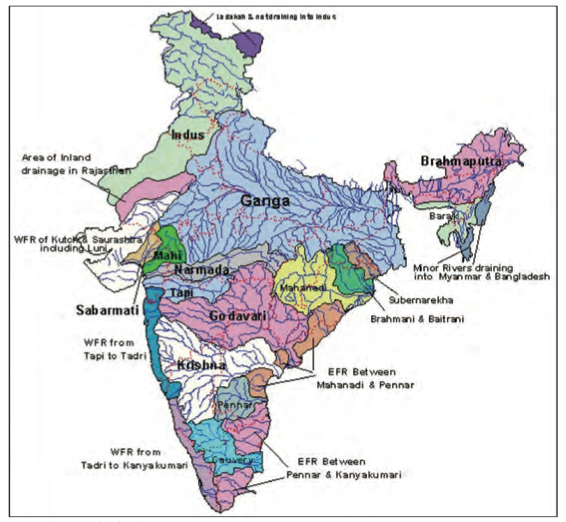
Figure 1: River basin map of India (EFR: East flowing rivers, WFR: West flowing rivers)
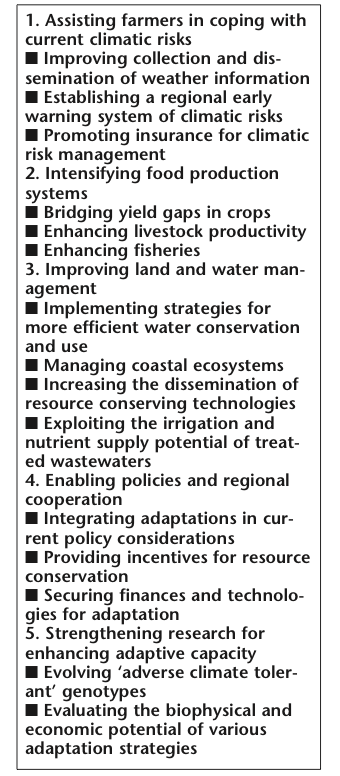
Box 1: Key Adaptation Strategies for Indian Agriculture (Adapted from Reference 16)
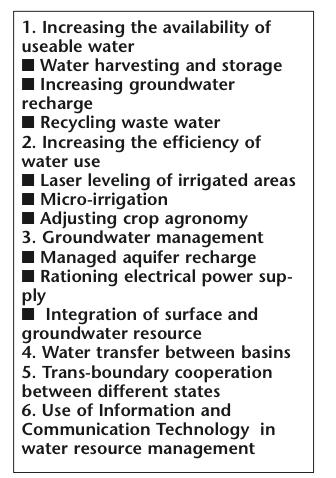
Box 2: Key adaptation strategies in the irrigation sector.
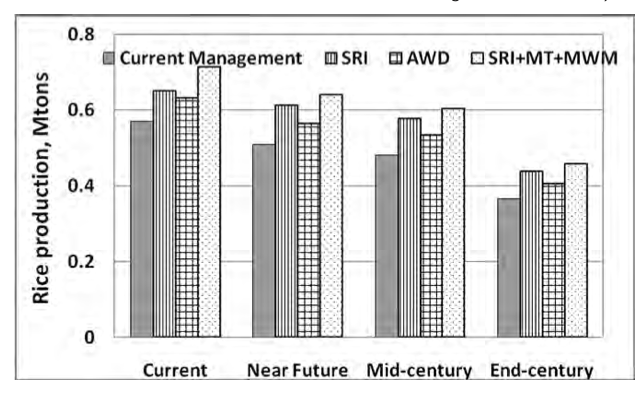
Figure 2: Predictions of future rice production under different future time scenarios and management options during Kharif season in Godavari Basin, Andhra Pradesh, India (8). System of rice intensification (SRI), machine transplantation (MT), alternate wetting and drying (AWD) and maize water management (MWM).
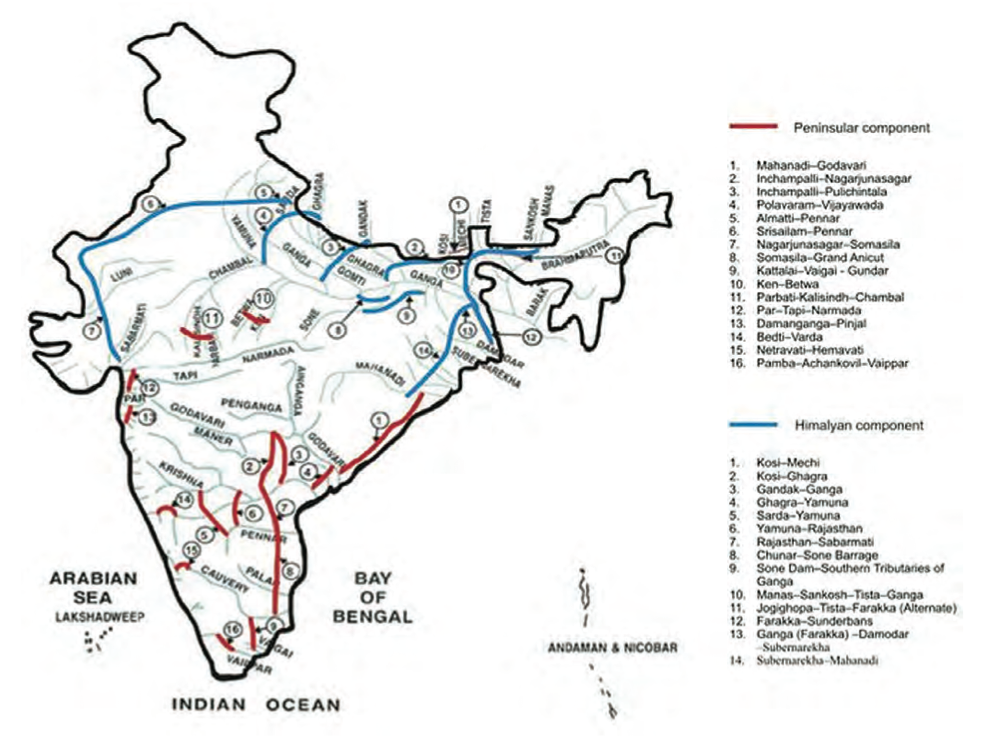
Figure 3. Himalayan and peninsular component of the inter river linking project ( Source: 22).

